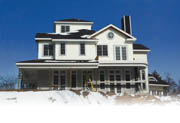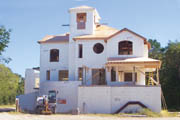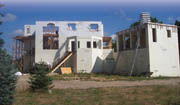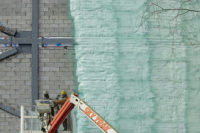
A prime example of systems that are receiving quite a bit of positive press and advertising space of late are insulated concrete forms. Their convergence on the market is creating a buzz of excitement, as they provide both a revolutionary method of construction and an exciting new profit opportunity for contractors and suppliers alike.
These systems are also available throughout the United States and in most foreign countries. They provide terrific opportunities to a growing number of participants in the wall and ceiling industry and have been available since the '80s; gaining traction in the late '90s.

There are always possibilties
Imagine the possibilities of promoting and/or installing ICFs-a proven construction system that facilitates a significant reduction in energy costs, extraordinary fire resistance, a cleaner and quieter interior environment, and the structural integrity to withstand hurricane-force winds. Additionally, ICFs are very green and will accept virtually any exterior cladding, with the most popular being EIFS and stucco.A terrific case study of an ICF project is the Holland residence in New Jersey. Dr. Nick Holland is the principal of a veterinary practice with multiple locations throughout southern New Jersey. Back in 2003, he and his wife Ellen were confronted with the dubious task of building their dream home, with the added burden of inside air quality, as their children were confronted with serious allergy problems. So they, along with architect Por Sen Jaw, embarked on this daunting task. It was at this time that they approached Rory and Tonia Ahern of Tara Contracting, a successful Amvic ICF distributor/installer, in a neighboring town.
Tara Contracting was successful in convincing both the owners and architects to build with ICFs, as the home, according to Tonia, "is very unique and features a particularly difficult design, incorporating radius and cantilevered walls with a flooring system that extends to numerous porches around the structure."
The Hollands were also enamored by the virtually indestructible (with the proximity to the Atlantic Ocean comes the very real possibility for hurricane force winds), fire-resistant nature of ICFs, as well as the fact that their home would be extremely energy efficient, while helping to provide the clean living environment necessary for their children's comfort and well-being.

Stucco and EIFS friendly
Although an EIF system was considered and, along with stucco, comprises 30 to 40 percent of all finished surface area of ICF structures, the Hollands chose cedar for their exterior walls, as it far more befits the turn-of-the-century coastal New England charm they so desired.ICFs are now regarded as one of the most innovative, fastest growing products on today's cluttered building products' menu. Architects, builders and building owners everywhere are quickly recognizing ICFs as an outstanding building technology.
In fact, Dave Neff, president of Manning Materials Inc., one of Dryvit's largest distributors since 1973, considers ICFs the cornerstone of his company's recently implemented Performance Wall Solutions strategy, where "we offer our marketplace a single source for ICFs, interior moldings, exterior moldings and EIFS, as well as all the ancillary products utilized to install these systems. And, as our existing customer base is comprised of plasterers and carpenters, it provides them with a far greater opportunity for sustained growth."
Ed Scherrer, of Performance Building Products, a Polysteel ICF distributor, shares a similar opinion, claiming that ICFs provide his company with "the vehicle for more opportunities to enhance our business, as we become more of a true ‘building systems' distributor in the Twin Cities of Minnesota."
Most readers already know about the availability of EIFS but as for ICFs, there is ample competitive availability with 15 to 20 national brands, representing all of North America, as well as more regional systems throughout the country. They are comprehensively tested, have a very positive track record, and the Insulated Concrete Form Association is very viable, representing the industry in a very professional manner.
An interesting aside to this distribution model shift, and one shared by Dave Neff, are "the amazing benefits of ICFs as a way to both construct a building and complement and expand our EIFS business. Remember, 30 to 40 percent of all ICFs are finished off in EIFS, modified stucco with acrylic finish, or stucco. What a tremendous opportunity to develop one's commercial and residential business, well into the future. Plus, it totally eliminates the perceived issue of moisture intrusion in residential construction."
ICFs meet, or exceed, virtually all requisite codes and standards, while providing comfort, unmatched energy efficiency, safety and design flexibility. They offer an incomparable permanent building solution to an increasing number of fortunate building owners, as well as fresh business opportunities for a whole new group of energetic and creative entrepreneurs.
ICFs are certainly a force in our current construction environment as they are providing a jolt of adrenalin in helping a growing number of dynamic and progressive wall and ceiling professionals foresee an exciting and lucrative vision of their collective futures.

